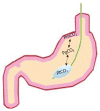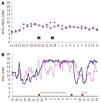Diagnosis and management of splanchnic ischemia
- PMID: 19109864
- PMCID: PMC2778114
- DOI: 10.3748/wjg.14.7309
Diagnosis and management of splanchnic ischemia
Abstract
Splanchnic or gastrointestinal ischemia is rare and randomized studies are absent. This review focuses on new developments in clinical presentation, diagnostic approaches, and treatments. Splanchnic ischemia can be caused by occlusions of arteries or veins and by physiological vasoconstriction during low-flow states. The prevalence of significant splanchnic arterial stenoses is high, but it remains mostly asymptomatic due to abundant collateral circulation. This is known as chronic splanchnic disease (CSD). Chronic splanchnic syndrome (CSS) occurs when ischemic symptoms develop. Ischemic symptoms are characterized by postprandial pain, fear of eating and weight loss. CSS is diagnosed by a test for actual ischemia. Recently, gastro-intestinal tonometry has been validated as a diagnostic test to detect splanchnic ischemia and to guide treatment. In single-vessel CSD, the complication rate is very low, but some patients have ischemic complaints, and can be treated successfully. In multi-vessel stenoses, the complication rate is considerable, while most have CSS and treatment should be strongly considered. CT and MR-based angiographic reconstruction techniques have emerged as alternatives for digital subtraction angiography for imaging of splanchnic vessels. Duplex ultrasound is still the first choice for screening purposes. The strengths and weaknesses of each modality will be discussed. CSS may be treated by minimally invasive endoscopic treatment of the celiac axis compression syndrome, endovascular antegrade stenting, or laparotomy-assisted retrograde endovascular recanalization and stenting. The treatment plan is highly individualized and is mainly based on precise vessel anatomy, body weight, co-morbidity and severity of ischemia.
Figures




References
-
- Reiner L, Jimenez FA, Rodriguez FL. Atherosclerosis in the mesenteric circulation. observations and correlations with aortic and coronary atherosclerosis. Am Heart J. 1963;66:200–209. - PubMed
-
- Kolkman JJ, Otte JA, Groeneveld AB. Gastrointestinal luminal PCO2 tonometry: an update on physiology, methodology and clinical applications. Br J Anaesth. 2000;84:74–86. - PubMed
-
- Otte JA, Geelkerken RH, Oostveen E, Mensink PB, Huisman AB, Kolkman JJ. Clinical impact of gastric exercise tonometry on diagnosis and management of chronic gastrointestinal ischemia. Clin Gastroenterol Hepatol. 2005;3:660–666. - PubMed
-
- Mensink PB, van Petersen AS, Kolkman JJ, Otte JA, Huisman AB, Geelkerken RH. Gastric exercise tonometry: the key investigation in patients with suspected celiac artery compression syndrome. J Vasc Surg. 2006;44:277–281. - PubMed
Publication types
MeSH terms
LinkOut - more resources
Full Text Sources

